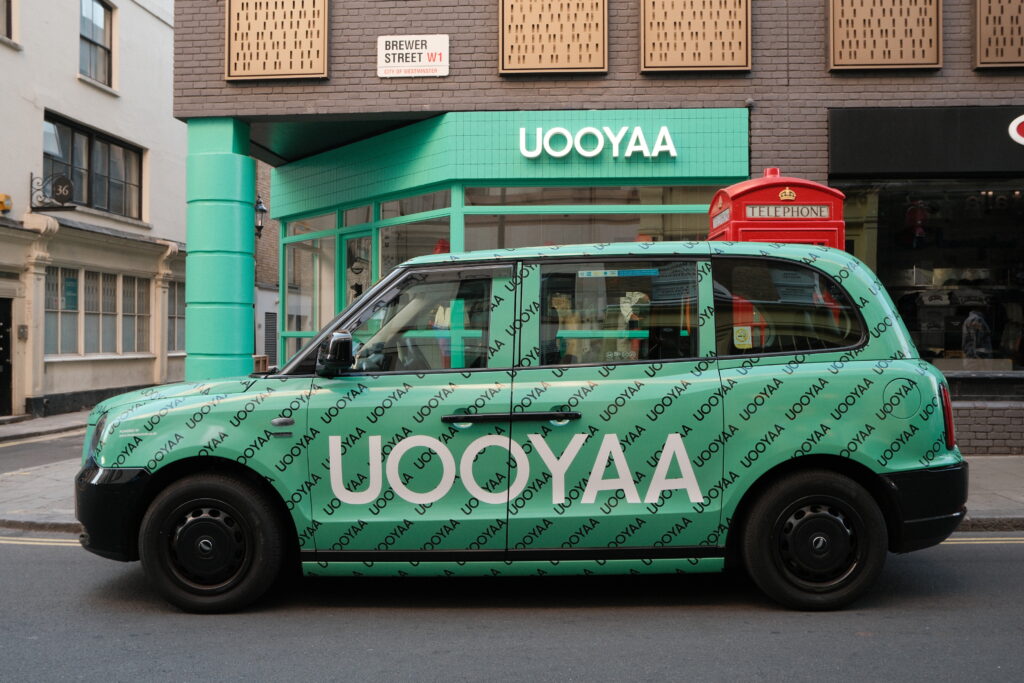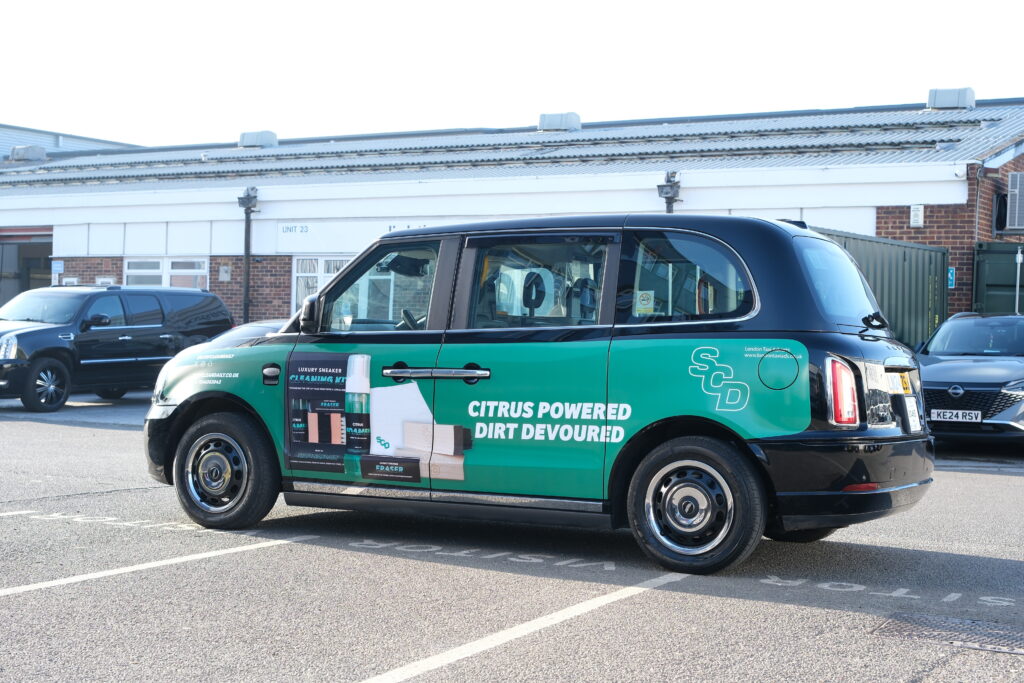Most urban marketers today face the same challenge: rising spend, shrinking visibility. As digital platforms get noisier and audiences become harder to engage, high-growth brands are rethinking how they stay visible in the real world and where they can still win attention on their terms.
Taxi advertising has re-emerged as a standout strategy for brands looking to dominate street-level visibility without depending on algorithms or fleeting impressions. In high-density markets like London, it offers guaranteed exposure in high-traffic, decision-making zones where audiences are present, alert, and receptive.
And the data backs it up. Mobile outdoor advertising formats like taxis generate up to 2.5x more attention than static OOH. In London, a single branded taxi can deliver over 900,000 impressions per month.
We’ll break down how taxi advertising works and how to structure campaigns that align with your commercial objectives. First, let’s look at what’s changed in urban advertising and why mobility now gives brands an edge.
The Shifting Pulse of Urban Advertising
Urban audiences are harder to reach than ever. Ad-blockers are everywhere. Banner fatigue is real. Social media costs keep climbing while attention spans keep falling. Traditional billboards? Often ignored or lost in the noise.
But the streets haven’t stopped moving, and neither have your customers. In London, taxis cover high-density, high-value zones from morning rush to late-night footfall. Forward-thinking marketers are turning that movement into measurable exposure.
Taxi advertising is a strategy. Mobile formats like branded cabs combine physical presence with location precision. They show up where your audience already is: Soho, Southbank, Shoreditch, Stratford.
And the numbers prove it. Mobile OOH formats capture 2.5 times more attention than static displays. In London, one branded taxi can rack up 30,000 impressions a day, crossing over 150 miles of prime real estate. For brands targeting urban professionals, that’s unmatched reach per square mile.
Today’s taxi advertising goes well beyond rooftop signs. Full-body wraps, digital screens, interior displays, and even interactive elements give brands the tools to build awareness or drive direct action, depending on the goal.
How Taxi Advertising Works and Why It Delivers?

Taxi advertising goes far beyond placing a logo on a vehicle. In high-density cities like London, it functions as a mobile billboard, brand activation tool, and targeted reach vehicle all in one. It’s visible, versatile, and engineered for real-world impact. Here’s how brands are using it to drive measurable results:
1. Exterior Advertising That Moves With Your Market
a. Full Vehicle Wraps
A fully wrapped taxi acts as a moving brand ambassador. From financial districts to retail hubs, these high-impact formats dominate visual space. They’re especially effective for brand launches, awareness campaigns, and high-frequency messaging across key London corridors.
b. Partial Wraps, Doors, and Decals
More cost-efficient but still visually strong, these formats allow brands to show up consistently while maintaining campaign flexibility. It is ideal for geographic targeting or time-sensitive messaging like event tie-ins and promotions.
c. Roof-Mounted Displays (Static or Digital)
High-visibility and multi-angle exposure make rooftop signage a solid choice for city-wide reach. LED versions allow for rotating creatives, message sequencing, or even shared ad space, offering frequency at scale.
2. Interior Messaging With High Dwell Time
Taxis give brands access to a unique setting, an enclosed space with a captive audience. Inside-the-cab formats include:
a. Seat-Back Panels and Partition Screens
These placements are impossible to ignore and ideal for detailed messaging, QR codes, or app installs. Average ride time? 10–20 minutes of direct exposure.
b. Interactive Touchpoints
Some campaigns integrate NFC tags or scannable offers, enabling real-time engagement from booking demos to downloading apps.
3. Geographic Targeting and Route Optimization
One of taxi advertising’s biggest advantages over traditional OOH is flexibility. Campaigns can be geo-planned to ensure presence in high-value areas, think Canary Wharf for B2B, Shoreditch for tech and culture, or Heathrow for global luxury.
Leading taxi advertising companies in London offer route planning tools and heatmap data to match fleet movement with audience footprint. This ensures your message lands in the right place, at the right time, without wasted impressions.
4. Seamless Integration With Digital Strategy
Taxi campaigns increasingly support omnichannel strategies. Vehicles can carry:
- Landing page URLs and UTM codes
- QR codes tracked to conversions
- Retargeting signals for digital follow-up
Ad taxis become physical entry points into digital funnels, creating a tangible, high-frequency layer in the customer journey.
5. Campaign Duration and Agility
So, how long do taxi ad campaigns typically run? Brands generally run campaigns between 4 and 12 weeks, depending on objectives. Short bursts (2–3 weeks) work well for event-driven activations, while longer campaigns support consistent visibility and recall.
Unlike static billboards, taxi routes can be adjusted mid-campaign, letting marketers respond to seasonal events, product launches, or changing consumer behavior. This adaptability is critical for brands operating in fast-paced urban environments.
The Business Case for Taxi Advertising
Taxi advertising is effective. In competitive cities like London, where visibility equals value, this format delivers real-world reach, recall, and results that outperform many digital and static OOH channels.
1. High Reach, Zero Scroll Fatigue
A single branded taxi in London can generate over 3,000 impressions per day. A fleet of 50 vehicles running across a 30-day campaign translates to 4.5 million on-street views in high-density decision-making zones. Unlike digital ads, these are seen in real life, in motion.
2. Stronger Brand Recall
Mobile out-of-home formats like Ad taxis deliver a 32% lift in brand recall compared to static billboards. The movement of the vehicle, combined with repeated exposure along familiar routes, makes your brand more memorable. People remember what moves and what moves with them.
3. Efficient, Scalable Investment
Compared to CPMs in paid social or digital OOH, the value per impression remains one of the most cost-efficient in the urban ad ecosystem. These rates typically include production, installation, and basic tracking. Add-ons like digital displays, GPS-based routing, or targeted scheduling enhance performance through smarter reach and reporting.
Campaigns generally require a minimum of 10–50 vehicles over 4–8 weeks to achieve frequency and visibility targets. Larger fleet buys unlock volume discounts and allows for more granular targeting across city zones.
4. Funnel Flexibility, Strategic Precision
Taxi advertising supports every stage of the funnel:
- Top of Funnel: Full wraps and rooftop displays maximize visibility for brand awareness
- Mid to Bottom Funnel: Interior placements drive consideration and conversion with QR codes, URLs, or exclusive offers
- Route optimization allows brands to target specific zones Canary Wharf for B2B, Oxford Street for retail, and Shoreditch for tech and culture.
5. Measurable Performance, Real-World Attribution
Modern taxi campaigns are backed by robust tracking and analytics:
- GPS-based route data shows exactly where your ads traveled and how often.
- A/B testing on digital formats enables live message optimization.
- QR codes, UTM links, and promo codes tie physical impressions to digital actions from app downloads to sign-ups and purchases.
Brands can evaluate performance across multiple metrics such as impressions, engagement, recall, and conversions for full-funnel visibility.
London Taxi Advertising: Compliance and Creative Best Practices

Running a taxi advertising campaign in London offers unmatched visibility. But it also requires strategic investment and operational precision. From pricing to regulations, here’s what you need to know to launch a campaign that delivers both impact and compliance.
Regulatory Compliance: TfL and Creative Approvals
Transport for London (TfL) enforces strict advertising standards on licensed taxis. All creatives must be submitted for approval and this process takes 2–3 weeks. Regulated categories like alcohol, gambling, and politics face tighter restrictions, which may delay approval or require revisions.
In addition:
- Vehicle wraps must meet TfL’s visibility and safety standards.
- All installations must be professionally executed and removable without damage.
- Brands should plan for approval timelines early to avoid campaign delays.
Creative and Cultural Best Practices
To resonate in London’s diverse market, campaigns must balance creative clarity with cultural relevance.
- Keep it simple: London traffic moves fast. Messages must be readable in under 3 seconds. Use bold typography, high contrast, and clean design.
- Design for conditions: Rain, fog, and winter glare can obscure subtle visuals. Build for readability in all weather and lighting.
- Reflect the city, but don’t narrow your reach: Local references and landmarks help campaigns feel relevant. But avoid niche messaging that may alienate broader audiences.
- Adapt for motion: A message that works on a digital screen won’t necessarily land on a moving vehicle. Test the creative in real-world settings before rollout.
Conclusion: Turn Traffic Into Attention
Visibility is a competitive necessity in markets defined by noise and fragmentation. Taxi advertising offers a consistent, physical presence in the places where decisions actually happen. Yet the pressure hasn’t eased.
Brands still face shrinking windows of recall, tighter budgets, and the need to prove impact across every channel. Without a partner who understands how to navigate real-world media with precision, campaigns just become another passing impression. The difference lies in execution, and not every team is built for that kind of ground game.
FAQs
1. Are taxi ads effective for brand awareness?
Yes. Taxi ads deliver high exposure through repeated visibility in daily routines. Studies show they boost brand recall by up to 40% compared to static OOH formats.
2. What are the benefits of taxi advertising over digital?
Taxi ads guarantee 100% visibility, avoid ad-blockers, and reach audiences during real-world moments of attention.
3. How much should brands budget for London taxi advertising?
Budgets vary by format.
4. Where does taxi advertising work best?
Urban hotspots with high traffic and footfall. In London, key zones include Canary Wharf, Oxford Street, Shoreditch, and major airports or hotel districts.
5. How long should taxi ad campaigns run?
6–12 weeks is ideal. This allows enough frequency for recall. Shorter runs can raise awareness; longer campaigns support sustained brand presence and impact.
6. What makes a taxi ad creative successful?
Bold visuals, clear branding, and simple messages. Use large text, high contrast, and limit detail. Designs must work at a glance and in motion.
